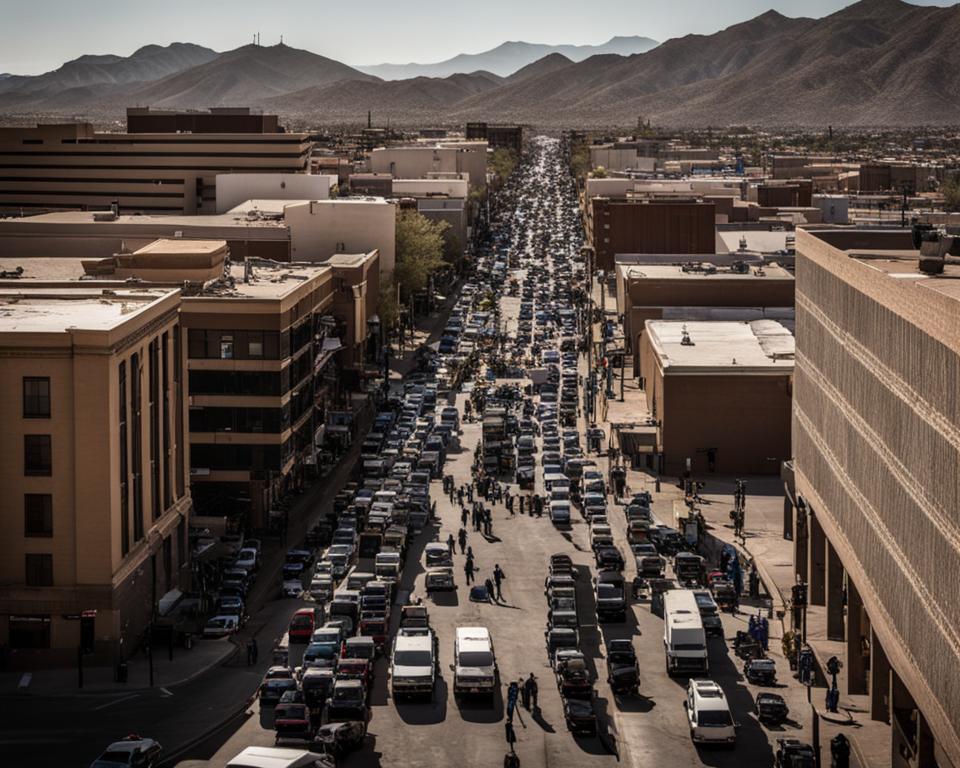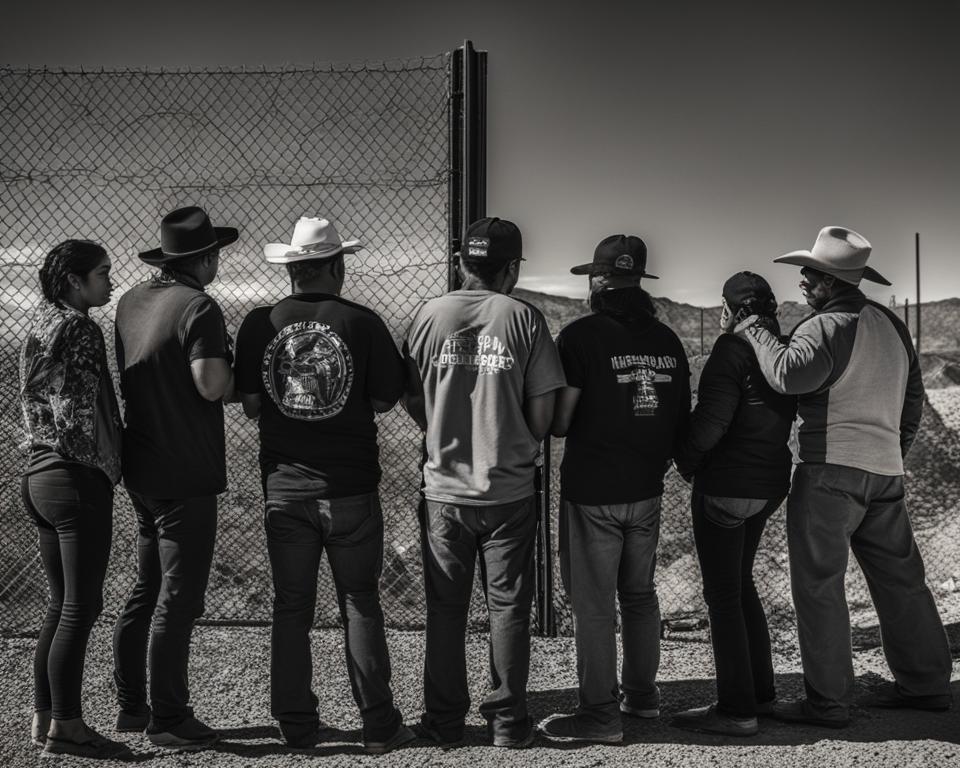In recent years, the city has experienced a significant increase in migrants arriving at its borders. This influx has strained local resources and has become a pressing issue that needs to be addressed. In this Page, we will explore the challenges surrounding El Paso’s immigration crisis and look into its implications on the El Paso city community.
Key Takeaways:
- El Paso has seen a steady increase in migrants arriving since 2018.
- The surge in April 2022 and the significant jump in August have further exacerbated the situation.
- On average, around 900 migrants are released to local organizations in El Paso every day.
- Migrants primarily come from countries such as Venezuela, Ecuador, El Salvador, Haiti, Nicaragua, and Cuba.
- The strain on resources has led to the need for additional assistance to cope with the immigration crisis.
El Paso Immigrant Wave
The current wave of migrants coming to El Paso started in April 2022 but saw a sudden surge in August. The number of people released to the city and local NGOs has grown from approximately 250 per day in early August to over 1,000 per day in September. The number fluctuates daily but is currently averaging 900 per day. This increase has put pressure on the city’s infrastructure and resources.
The surge in August has overwhelmed the usual shelters and hotel rooms designated for migrants. As a result, additional shelters have been opened in recreational centers and vacant schools to accommodate the growing number of individuals seeking refuge. The city officials are working tirelessly to avoid street releases and ensure that all migrants released into the community are accommodated.
The sudden influx of migrants has strained the city’s resources and necessitated additional assistance. The surge in August has highlighted the urgent need for support and comprehensive immigration policy reform to manage the ongoing immigration crisis in El Paso effectively.
El Paso Immigrants by Nationality
The migrants coming to El Paso represent a diverse range of nationalities. Most migrants currently arriving in El Paso are from Venezuela, accounting for approximately 70% of the total number. Other countries represented include Ecuador, El Salvador, Haiti, Nicaragua, and Cuba. Each of these nationalities brings its own unique set of circumstances and challenges, contributing to the complexity of the immigration situation in El Paso.
To provide a clearer understanding of the nationalities of migrants in El Paso, we have compiled the following table:
| Nationality | Percentage |
|---|---|
| Venezuela | 70% |
| Ecuador | X% |
| El Salvador | X% |
| Haiti | X% |
| Nicaragua | X% |
| Cuba | X% |
Please note that the percentage values for nationalities other than Venezuela are currently unavailable. Recognize that the composition of nationalities may vary over time as migration patterns change and new trends emerge.
“The diversity of nationalities among migrants in El Paso highlights the global nature of migration and the need for comprehensive and adaptable immigration policies.” – Immigration Expert
Strain on El Paso Resources
The influx of migrants has put a significant strain on El Paso’s resources. The usual shelters and hotel rooms designated for migrants have reached capacity, leading to the opening of additional shelters in recreational centers and vacant schools. The city has stated that all migrants released into the community will be provided with accommodation to avoid street releases. However, some migrants have opted to stay on the streets for distrust or other reasons.
Challenges Faced by El Paso
The strain on resources has created challenges for both the migrants and the city of El Paso. With limited shelter options, some migrants are left without proper accommodations, forcing them to seek temporary shelter outdoors. This not only exposes them to harsh weather conditions but also puts them at risk of exploitation and danger.
- Increased demand for food and water:
The growing number of migrants in El Paso has increased the demand for essential resources such as food and water. Local organizations and volunteers have been working tirelessly to meet this increased need, but the strain on resources has made it difficult to ensure everyone’s needs are adequately met.
- Struggling infrastructure:
The migrant surge has placed additional pressure on El Paso’s infrastructure, including transportation and healthcare systems. The increased demand for transportation services to accommodate the growing number of migrants has stretched the city’s capabilities, leading to delays and challenges in providing timely assistance.

The immigration crisis in El Paso has significantly strained the city’s resources. The lack of available shelter options has forced some migrants to stay on the streets, exposing them to numerous challenges and risks. The increasing demand for essential resources and the pressure on infrastructure have further exacerbated the situation. Urgent action and additional support are needed to alleviate the strain on El Paso’s resources and address the ongoing immigration crisis.
Challenges Faced by El Paso Immigrants
Immigrants in El Paso face numerous challenges as they navigate through the complex immigration system and seek to establish a new life in the United States. The current humanitarian crisis at the border has only exacerbated these difficulties, leaving many individuals and families in a state of uncertainty and vulnerability.
One key challenge faced by El Paso immigrants is the lack of resources available to them. Many arrive in the city with limited financial means and struggle to access necessities such as food, housing, and healthcare. The strain on local resources has made it even more challenging for immigrants to find the support they need to rebuild their lives.
The uncertainty surrounding immigration policies and procedures adds to the challenges immigrants face in El Paso. Many are unsure of their legal rights and the steps they must take to regularize their status. Without proper guidance and information, they may be at risk of falling prey to false information or fraudulent individuals who exploit their vulnerability.
Challenges Faced by El Paso Immigrants
| Challenges | Impact |
|---|---|
| Limited access to resources | Difficulty in accessing basic necessities and services |
| Uncertainty about legal rights | Risk of exploitation and misinformation |
| Language and cultural barriers | Obstacles in communication and integration |
| Discrimination and xenophobia | Challenges in finding employment and facing hostility |
Furthermore, language and cultural barriers can pose significant obstacles for immigrants in El Paso. Many newcomers are non-English speakers and may struggle to communicate effectively or navigate the intricacies of the American society. This can hinder their integration process and limit their opportunities for economic and social advancement.
Lastly, immigrants in El Paso may also face discrimination and xenophobia, which can have a profound impact on their overall experience and well-being. Prejudice and hostility towards immigrants can make it difficult for them to find employment, access education, and feel a sense of belonging in their new community.
In conclusion, El Paso immigrants confront numerous challenges on their journey towards a better life in the United States. From limited access to resources and uncertainty about legal rights to language barriers and discrimination, these individuals face a multitude of obstacles. It is essential for society to recognize and address these challenges in order to create an inclusive and supportive environment for all immigrants in El Paso.
El Paso’s Response to the Immigration Crisis
In the face of the ongoing immigration crisis, El Paso has actively taken measures to provide assistance and support to the increasing number of migrants in their community. Recognizing the importance of prioritizing the well-being of individual migrants, the city has implemented various initiatives to address their immediate needs. El Paso’s response includes offering essential resources such as food, water, connectivity, transportation assistance, and temporary shelter as needed.
El Paso officials have made significant efforts to meet their goal of providing accommodation to released migrants, thus avoiding street releases. However, shelters designated for migrants and hotel rooms have reached capacity, leading to the opening of additional shelters in recreational centers and vacant schools. These temporary arrangements ensure that all migrants have access to a safe and secure place to stay while awaiting further processing or making their next steps.
While El Paso has made commendable efforts to assist migrants, the city has reached its breaking point. The surge in arrivals has strained their resources, limiting their ability to manage the ongoing immigration crisis effectively. In light of these challenges, El Paso is seeking additional aid from the Biden administration to support its efforts in providing humanitarian assistance and managing the influx of migrants.
| El Paso’s Response to the Immigration Crisis | Assistance Provided |
|---|---|
| Food | Meals and food supplies |
| Water | Bottled water and hydration stations |
| Connectivity | Access to communication devices and internet services |
| Transportation | Assistance with transportation arrangements |
| Temporary Shelter | Opening additional shelters in recreational centers and vacant schools |
“El Paso has been a beacon of hope for many migrants seeking refuge. We are committed to ensuring their well-being and providing the necessary support to navigate this challenging journey.” – El Paso City Official
Criminal Groups and False Information
Customs and Border Patrol (CBP) has raised concerns about criminal groups operating in the El Paso and Juarez region. These groups spread false information that endangers the lives of migrants for profit. CBP emphasizes the importance of enforcing immigration laws and dispelling the misconception that the U.S.-Mexico border is open to illegal immigration.
The rise of criminal groups in the area has created a dangerous environment for migrants seeking a better life. These organizations exploit vulnerable individuals by providing false promises, such as guaranteed entry into the United States or safe transportation across the border. As a result, migrants put their lives at risk by relying on these criminal networks, often facing violence, extortion, or abandonment along the journey.
CBP, in collaboration with local law enforcement agencies, is working to dismantle these criminal operations and ensure the safety of migrants. By increasing border security measures and targeting the organizations responsible for spreading false information, CBP aims to protect vulnerable individuals and prevent further exploitation. Enhanced intelligence sharing and coordinated efforts with Mexican authorities are also crucial in addressing the transnational nature of these criminal networks.
It is essential for the public to be aware of the risks associated with relying on criminal groups and false information. Migrants should seek proper legal guidance and explore legitimate pathways for immigration instead of putting their lives in the hands of criminals. Addressing the root causes of migration, such as economic instability and violence in sending countries, can help mitigate the desperation that leads individuals to seek illegal routes.
Border Security and Senate Complications
The issue of border security has become a complicating factor in the Senate, with Republicans seeking to address the situation through amendments to the STOP GAP bill. The ongoing challenges at the border highlight the need for immigration policy reform and comprehensive approaches. Urgent action from Congress is necessary to address the current situation effectively.
The border security issue is contentious, with stakeholders varying views on the best course of action. Republicans argue that stricter border security measures are necessary to deter illegal immigration and protect national security. They propose amendments to the STOP GAP bill that would allocate additional funding for border patrol agents, technology, and infrastructure.
Democrats, on the other hand, emphasize the need for a more humanitarian approach to immigration. They advocate for measures that prioritize the well-being and fair treatment of migrants while also addressing the root causes of migration from Central America. Democrats argue that comprehensive immigration policy reform is needed to create a fair and just system that provides pathways to legal status for undocumented immigrants.
“The ongoing challenges at the border highlight the need for immigration policy reform and comprehensive approaches.”
With the Senate split between the two major parties, finding common ground on border security and immigration policy reform has proven challenging. The deadlock has led to increased frustration among advocacy groups, immigration lawyers, and communities directly impacted by the border crisis.
While the debate continues in Congress, the situation at the border remains complex and unresolved. It is imperative for lawmakers to come together and find bipartisan solutions that address both border security concerns and the humanitarian aspects of the immigration system. Only through collaboration and compromise can the United States effectively manage its immigration challenges and uphold its values as a nation of immigrants.

Border Strain and Services in Southern California
The strain felt in El Paso is not unique; cities and small towns along the U.S. border with Mexico also face challenges. Southern California, in particular, has been experiencing the impact of the influx of migrants, prompting the county board of supervisors to declare a humanitarian crisis. The strain on resources and services has been a pressing concern in the region.
Border agents, to alleviate pressure on shelters and services in San Diego, have been dropping off migrants as far north as Oceanside, California. This distribution strategy aims to distribute the burden more evenly across the region. However, the availability of federal resources has been insufficient to handle the current migrant influx adequately.
The table below provides a comparison of the strain on resources and services in El Paso and Southern California:
| Challenges | El Paso | Southern California |
|---|---|---|
| Shelter Capacity | Reached capacity, opening additional shelters in recreational centers and vacant schools | Strain on shelters and services, drop-offs in Oceanside to relieve pressure in San Diego |
| Resource Availability | City resources strained, seeking additional aid from the Biden administration | Insufficient federal resources to handle the current influx |
| Humanitarian Crisis Declaration | – | County board of supervisors declared a humanitarian crisis |
The situation in Southern California highlights the urgent need for comprehensive immigration policy reform and increased support from the federal government. With the strain on resources and services, local communities require immediate assistance to address the ongoing challenges and provide humanitarian aid to needy migrants.
Lack of Immigration Pathways
The current immigration crisis in El Paso is further compounded by the lack of clear and accessible pathways for migrants, particularly those from Central American countries. The ongoing economic and political crises in countries such as Honduras, Guatemala, and El Salvador have pushed individuals to seek better opportunities in the United States. However, without viable immigration options, many have no choice but to take the risky journey to the border.
The absence of established immigration pathways not only puts migrants at risk but also hinders effective border management and humanitarian assistance. Without clear guidelines and legal channels for migration, individuals are forced to rely on irregular and often dangerous methods to enter the country. This leads to an increase in human trafficking, exploitation, and the overcrowding of detention facilities.
“The lack of immigration pathways exacerbates the challenges faced by both migrants and border communities,” says immigration attorney Maria Rodriguez. “It’s crucial for the U.S. government to create a comprehensive and humane immigration system that provides safe and legal options for individuals seeking a better life.”
Central American Crisis and the Need for Reform
The Central American crisis is a complex issue that requires a multifaceted approach. While addressing the root causes of migration is essential, it is equally important to establish clear and accessible immigration pathways that provide individuals with a fair chance to seek refuge or obtain work authorization legally.
Comprehensive immigration policy reform is urgently needed to address the humanitarian crisis at the border and provide a long-term solution to the challenges faced by El Paso and other border communities. This reform should prioritize the protection of human rights, the fair and efficient processing of asylum claims, and the establishment of legal pathways for those seeking opportunities in the United States.
Call for Congressional Accountability
As the immigration crisis continues to unfold in El Paso, Congress must be held accountable and take immediate action to address this pressing issue. Immigration attorney Kathleen Campbell Walker emphasizes the urgent need for comprehensive immigration policy reform to tackle the challenges faced by El Paso immigrants effectively.
The situation at the border demands a comprehensive response and a reevaluation of the current immigration system. Pressure must be put on Congress to prioritize the humanitarian crisis and work towards providing workable solutions for those seeking refuge in the United States.
With the strain on El Paso’s resources, the opening of additional shelters, and the overwhelming number of migrants, it is evident that the immigration system has reached a breaking point. Congress must take responsibility and enact meaningful changes to create logical immigration pathways, address bureaucratic delays, and provide a comprehensive approach to the current crisis.
It is essential for individuals to voice their concerns and exert pressure on Congress to enact immigration policy reform. By doing so, we can advocate for a system that reflects compassion, efficiency, and fairness while addressing the urgent needs of El Paso immigrants and the communities that support them.
FAQ
How has the number of migrants arriving in El Paso changed over time?
The number of migrants arriving in El Paso has been steadily increasing since 2018, with a surge in April 2022 and a significant jump in August. The city has seen a rise in the number of individuals released to local organizations, averaging around 900 per day.
Which countries do the majority of migrants in El Paso come from?
The majority of migrants in El Paso come from countries such as Venezuela, Ecuador, El Salvador, Haiti, Nicaragua, and Cuba.
How has the influx of migrants affected El Paso’s resources?
The influx of migrants has put a significant strain on El Paso’s resources, leading to the need for additional assistance. The usual shelters and hotel rooms designated for migrants have reached capacity, and additional shelters have been opened in recreational centers and vacant schools.
What challenges do migrants in El Paso face?
Migrants in El Paso face challenges such as a lack of resources and uncertainty about their next steps. Many arrive without a specific destination in mind, making it difficult for them to access support or find work.
How is El Paso providing assistance to migrants?
El Paso prioritizes the well-being of individual migrants and offers food, water, connectivity, transportation assistance, and temporary shelter as needed. The city has largely met its goal of providing accommodation to released migrants and has avoided street releases.
What is the situation with criminal groups and false information?
Customs and Border Patrol (CBP) has raised concerns about criminal groups operating in the El Paso and Juarez region. These groups spread false information that endangers the lives of migrants for profit.
How are Senate complications affecting the border situation?
The border security issue has become a complicating factor in the Senate, with Republicans seeking to address the situation through amendments to the STOP GAP bill. Urgent action from Congress is necessary to address the current situation effectively.
How are services in Southern California affected by the migrant influx?
In Southern California, the county board of supervisors has declared a humanitarian crisis due to the influx of migrants. Border agents have been dropping off migrants as far north as Oceanside, California, to alleviate pressure on shelters and services in San Diego.
Why are there no logical immigration pathways for the current situation?
Central American countries are experiencing significant crises, leading individuals to view reaching the U.S. border as a means of gaining work authorization and a better life. However, there are currently no logical immigration pathways to address the situation effectively.
What is the call for Congressional accountability about?
Immigration attorney Kathleen Campbell Walker highlights the urgent need for Congress to be accountable and take action on immigration policy reform. Individuals are encouraged to put pressure on Congress to address the humanitarian crisis and provide workable solutions.

